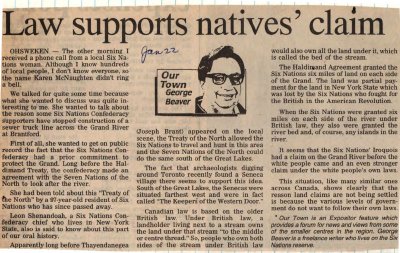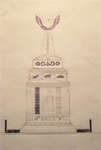"Law supports natives' claim"
- Publication
- Brantford Expositor, 22 Jan 1994
- Full Text
- Law supports natives' claim
OHSWEKEN - The other morning I received a phone call from a local Six Nations woman. Although I know hundreds of local people, I don't know everyone, so the name Karen McNaughton didn't ring a bell.
We talked for quite some time because what she wanted to discuss was quite interesting to me. She wanted to talk about the reason some Six Nations Confederacy supporters have stopped construction of a sewer truck line across the Grand River at Brantford.
First of all, she wanted to get on public record the fact that the Six Nations Confederacy had a prior commitment to protect the Grand. Long before the Haldimand Treaty, the confederacy made an agreement with the Seven Nations of the North to look after the river.
She had been told about this "Treaty of the North" by a 97-year-old resident of Six Nations who has since passed away.
Leon Shenandoah, a Six Nations confederacy chief who lives in New York State, also is said to know about this part of our oral history.
Apparently long before Thayendanegea (Joseph Brant) appeared on the local scene, the Treaty of the North allowed the Six Nations to travel and hunt in this area and the Seven Nations of the North could do the same south of the Great Lakes.
The fact that archaeologists digging around Toronto recently found a Seneca village there seems to support this idea. South of the Great Lakes, the Senecas were situated farthest west and were in fact called "The Keepers of the Western Door."
Canadian law is based on the older British law. Under British law, a landholder living next to a stream owns the land under that stream "to the middle or centre thread." So, people who own both sides of the stream under British law would also own all the land under it, which is called the bed of the stream.
The Haldimand Agreement granted the Six Nations six miles of land on each side of the Grand. The land was partial payment for the land in New York State which was lost by the Six Nations who fought for the British in the American Revolution.
When the Six Nations were granted six miles on each side of the river and under British law, they also were granted the river bed and, of course, any islands in the river.
It seems that the Six Nations' Iroquois had a claim on the Grand River before the white people came and an even stronger claim under the white people's own laws.
This situation, like many similar ones across Canada, shows clearly that the reason land claims are not being settled is because the various levels of government do not want to follow their own laws.
Our Town is an Expositor feature which provides a forum for news and views from some of the smaller centres in the region. George Beaver is a freelance writer who lives on the Six Nations reserve.
- Creator
- Beaver, George, Author
- Media Type
- Text
- Newspaper
- Item Type
- Clippings
- Publisher
- Brantford Expositor
- Place of Publication
- Brantford, ON
- Date of Publication
- 22 Jan 1994
- Subject(s)
- Personal Name(s)
- McNaughton, Karen ; Brant, Joseph ; Shenandoah, Leon.
- Corporate Name(s)
- Haudenosaunee Confederacy Chiefs Council.
- Local identifier
- SNPL003942v00d
- Collection
- Scrapbook #5
- Language of Item
- English
- Geographic Coverage
-
-
Ontario, Canada
Latitude: 43.06681 Longitude: -80.11635
-
- Creative Commons licence
 [more details]
[more details]- Copyright Statement
- Public domain: Copyright has expired according to Canadian law. No restrictions on use.
- Copyright Date
- 1994
- Copyright Holder
- Brantford Expositor
- Contact
- Six Nations Public LibraryEmail:info@snpl.ca
Website:
Agency street/mail address:1679 Chiefswood Rd
PO Box 149
Ohsweken, ON N0A 1M0
519-445-2954



